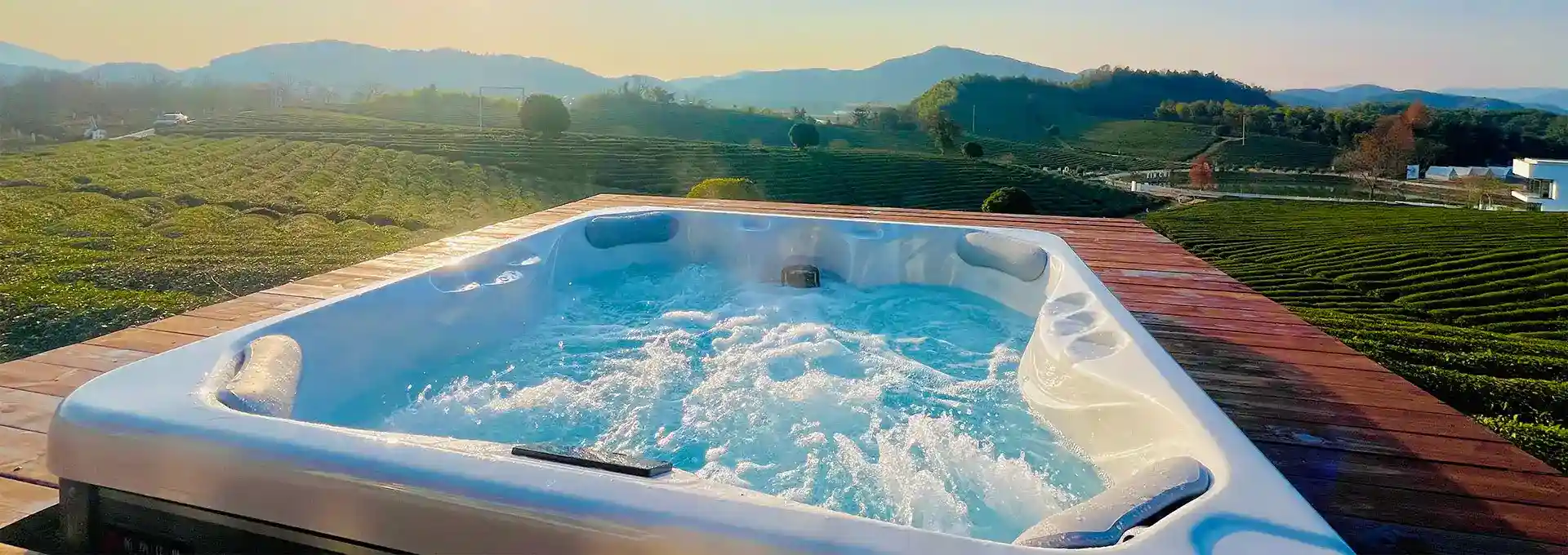Can You Put a Swim Spa in a Basement?
2024-07-19 17:16:10
Installing a swim spa in your basement can be an intriguing idea for homeowners looking to maximize their living space and enjoy year-round aquatic exercise. While it's not a common choice, placing a 6-person swim spa in a basement is indeed possible with proper planning and considerations. This unique installation can offer privacy, climate control, and convenient access to your swimming and fitness routine. However, there are several important factors to consider before embarking on such a project, including structural requirements, ventilation, access, and moisture control.
How much does a 6-person swim spa cost?
The cost of a 6-person swim spa can vary significantly depending on several factors, including the brand, features, and overall quality. On average, you can expect to pay anywhere from $20,000 to $50,000 for a high-quality 6-person swim spa. However, some luxury models with advanced features can cost upwards of $70,000 or more.
When considering the cost of a swim spa, it's important to factor in not just the initial purchase price, but also the long-term expenses associated with ownership. These additional costs may include:
1. Installation: Depending on the complexity of the installation, especially for a basement setup, you might need to budget an additional $5,000 to $15,000 or more for proper site preparation, electrical work, and professional installation.
2. Operating costs: Swim spas require electricity to run pumps, heaters, and filtration systems. Monthly energy costs can range from $50 to $250, depending on usage, local electricity rates, and the efficiency of the spa.
3. Maintenance: Regular maintenance, including water treatment chemicals, filter replacements, and occasional professional servicing, can add up to $500 to $1,000 per year.
4. Accessories: You may want to invest in additional items such as covers, steps, water care systems, or exercise equipment, which can cost anywhere from a few hundred to several thousand dollars.
5. Potential home modifications: For a basement installation, you might need to make structural changes or upgrades to your home, which could significantly increase the overall cost.
When shopping for a 6-person swim spa, it's crucial to compare different models and brands. Look for energy-efficient options that can help reduce long-term operating costs. Also, consider the warranty offered by the manufacturer, as a comprehensive warranty can save you money on potential repairs down the line.
Financing options are often available for swim spa purchases, which can make the initial investment more manageable. Some dealers offer in-house financing, while others may partner with third-party lenders to provide various payment plans.
Remember that while a swim spa represents a significant investment, it can also add value to your home and provide years of enjoyment, exercise, and relaxation for you and your family. When properly maintained, a high-quality swim spa can last 15-20 years or more, making it a worthwhile long-term investment for many homeowners.
What are the dimensions of a 6-person swim spa?
The dimensions of a 6-person swim spa can vary depending on the manufacturer and specific model. However, most 6-person swim spas typically fall within the following range:
- Length: 14 to 19 feet (4.3 to 5.8 meters)
- Width: 7 to 9 feet (2.1 to 2.7 meters)
- Depth: 4 to 5 feet (1.2 to 1.5 meters)
These dimensions are crucial to consider, especially when planning to install a swim spa in a basement. You'll need to ensure that your basement has adequate space not only for the swim spa itself but also for the surrounding area, which should include:
1. Access space: You'll need enough room to comfortably enter and exit the spa, as well as space for steps or a platform if necessary.
2. Maintenance area: Allow for extra space around the spa for routine maintenance and potential repairs.
3. Seating or lounging area: Consider leaving room for chairs or loungers near the spa for relaxation.
4. Equipment space: Swim spas require pumps, heaters, and filtration systems, which may need additional space depending on the configuration.
When measuring your basement for a swim spa installation, it's essential to account for doorways, stairs, and other potential obstacles. The swim spa will need to be transported into the basement, so you must ensure that all access points are wide and tall enough to accommodate the spa's dimensions.
Additionally, consider the ceiling height in your basement. You'll want enough headroom for comfortable use of the swim spa, including any standing or exercise activities. A minimum ceiling height of 7 to 8 feet (2.1 to 2.4 meters) is generally recommended, but taller ceilings can provide a more spacious feel.
Weight is another crucial factor to consider. A filled 6-person swim spa can weigh between 16,000 to 25,000 pounds (7,250 to 11,340 kg) or more. Your basement floor must be capable of supporting this weight, which may require structural reinforcement or modifications.
It's also worth noting that some swim spa manufacturers offer customizable dimensions or models specifically designed for indoor installations. These may have slightly different proportions or features optimized for indoor use, which could be beneficial for a basement installation.
Before finalizing your choice, it's highly recommended to consult with a structural engineer and a swim spa professional. They can assess your basement space, recommend the most suitable dimensions for your needs, and ensure that the installation meets all safety and building code requirements.
Can a swim spa be used as a pool?
Yes, a swim spa can indeed be used as a pool, offering many of the benefits of a traditional swimming pool in a more compact and versatile package. This dual functionality is one of the main attractions of swim spas, especially for homeowners with limited space or those looking for a more energy-efficient alternative to a full-sized pool.
Here are some ways in which a swim spa functions as a pool:
1. Swimming and Exercise: The primary feature of a swim spa is its ability to generate a current of water strong enough for swimming in place. This allows users to swim continuously without reaching the end of the spa, effectively simulating the experience of swimming laps in a much larger pool.
2. Water Depth: Most 6-person swim spas have a water depth suitable for swimming and other aquatic exercises. The depth typically ranges from 4 to 5 feet, which is adequate for most adults to swim comfortably.
3. Temperature Control: Unlike traditional pools, swim spas offer precise temperature control. This means you can adjust the water temperature to your preference, making it comfortable for both exercise and relaxation.
4. Year-Round Use: When installed indoors, such as in a basement, a swim spa can be used throughout the year, regardless of outdoor weather conditions. This gives it an advantage over many outdoor pools in regions with colder climates.
5. Hydrotherapy: Many swim spas come equipped with hydrotherapy jets, similar to those found in hot tubs. These jets can be used for relaxation and muscle therapy after a swim or workout.
6. Water Activities: While smaller than a traditional pool, a swim spa still provides enough space for various water activities. Children can play games, adults can do water aerobics, and families can enjoy time together in the water.
7. Low Impact Exercise: The buoyancy of water makes swim spas excellent for low-impact exercises, beneficial for people with joint issues or those recovering from injuries.
However, it's important to note that while a swim spa can function as a pool, there are some limitations compared to a full-sized swimming pool:
1. Space: Swim spas are more compact, which means less space for multiple people to swim simultaneously or for activities that require more room, like diving.
2. Depth Variety: Unlike some pools that have varying depths, swim spas typically have a uniform depth throughout.
3. Current Adjustment: While the current in a swim spa can be adjusted, some users may find it takes time to get used to swimming against a constant current.
4. Social Gatherings: Large pool parties or group water activities may be limited due to the smaller size of a swim spa compared to a traditional pool.
Despite these limitations, many homeowners find that a swim spa offers an excellent balance between the benefits of a pool and the compact size of a spa. This makes it an attractive option for those looking to install an aquatic feature in their basement or other indoor spaces.
When considering using a swim spa as a pool, especially in a basement setting, keep in mind factors such as ventilation, humidity control, and proper drainage. These elements are crucial for maintaining a comfortable and safe environment around your indoor swim spa.
In conclusion, while a 6-person swim spa may not replace every aspect of a full-sized pool, it offers a versatile and space-efficient alternative that can provide many of the same benefits, making it an excellent choice for fitness, relaxation, and family enjoyment, particularly in indoor settings like basements.
If you want to get more information about this product, you can contact us at info@iparnassus.com!
References:
1. Swim University. (2021). "The Ultimate Guide to Swim Spas."
2. Home Stratosphere. (2022). "Swim Spa Costs: Everything You Need to Know."
3. Aqua Magazine. (2020). "The Pros and Cons of Indoor Pool Installations."
4. Pool and Spa News. (2021). "Indoor Pool Design Considerations."
5. Swim Spa Guide. (2022). "Swim Spa Dimensions: Choosing the Right Size."
6. HGTV. (2019). "Everything You Need to Know About Swim Spas."
7. Hydropool. (2022). "Swim Spa Buyer's Guide."
8. Endless Pools. (2021). "Indoor vs. Outdoor Swim Spas: Pros and Cons."
9. Master Spas. (2022). "Swim Spa Installation Guide."
10. The Spruce. (2021). "What to Know Before Installing a Basement Pool."



